 W
WThe aardwolf is an insectivorous mammal, native to East and Southern Africa. Its name means "earth-wolf" in Afrikaans and Dutch. It is also called "maanhaar-jackal", "|gīb" by the Nama people, "ant hyena", "termite-eating hyena" and "civet hyena", based on its habit of secreting substances from its anal gland, a characteristic shared with the African civet. The aardwolf is in the same family as the hyena. Unlike many of its relatives in the order Carnivora, the aardwolf does not hunt large animals. It eats insects and their larvae, mainly termites; one aardwolf can lap up as many as 250,000 termites during a single night using its long, sticky tongue, the aardwolves tongue has adapted to be tough enough to withstand the strong bite of termites.
 W
WThe chacma baboon, also known as the Cape baboon, is, like all other baboons, from the Old World monkey family. It is one of the largest of all monkeys. Located primarily in southern Africa, the chacma baboon has a wide variety of social behaviors, including a dominance hierarchy, collective foraging, adoption of young by females, and friendship pairings. These behaviors form parts of a complex evolutionary ecology. In general, the species is not threatened, but human population pressure has increased contact between humans and baboons. Hunting, trapping, and accidents kill or remove many baboons from the wild, thereby reducing baboon numbers and disrupting their social structure.
 W
WThe large-eared free-tailed bat is a species of bat in the family Molossidae found in Angola, Central African Republic, Democratic Republic of the Congo, Ivory Coast, Djibouti, Ethiopia, Ghana, Kenya, Malawi, Rwanda, South Africa, Tanzania, Uganda, Yemen, Zambia, and Zimbabwe, and possibly Madagascar. Its natural habitats are subtropical or tropical dry forest, subtropical or tropical moist lowland forest, subtropical or tropical moist montane forest, dry savanna, arable land, and plantations. It is threatened by habitat loss.
 W
WThe blesbok or blesbuck is an antelope endemic to South Africa and Eswatini. It has a distinctive white face and forehead which inspired the name, because bles is the Afrikaans word for a blaze such as one might see on the forehead of a horse.
 W
WThe bontebok is a subspecies of Damaliscus pygargus, an antelope found in South Africa, Lesotho and Namibia. D. pygargus has two subspecies; the bontebok, occurring naturally in the Fynbos and Renosterveld areas of the Western Cape, and the blesbok occurring in the Highveld.
 W
WThe Cape bushbuck or bushbuck, as it is commonly known within its range, is a widespread species of antelope in Sub-Saharan Africa. To distinguish it from the kéwel, a close relative, some scientific literature refers to it as the imbabala. The two "bushbuck" species have been found to be more closely related to other members of the tragelaphine family than to each other – the imbabala namely to the bongo and sitatunga, and the kéwel to the nyala. Cape bushbuck are found in rain forests, montane forests, forest-savanna mosaic, savanna bush and woodland.
 W
WThe black-footed cat, also called the small-spotted cat, is the smallest wild cat in Africa, having a head-and-body length of 35–52 cm (14–20 in). Despite its name, only the soles of its feet are black or dark brown. With its bold small spots and stripes on the tawny fur, it is well camouflaged, especially on moonlit nights. It bears black streaks running from the corners of the eyes along the cheeks, and its banded tail has a black tip.
 W
WThe Southeast African cheetah is the nominate cheetah subspecies native to East and Southern Africa. The Southern African cheetah lives mainly in the lowland areas and deserts of the Kalahari, the savannahs of Okavango Delta, and the grasslands of the Transvaal region in South Africa. In Namibia, cheetahs are mostly found in farmlands.
 W
WThe common eland, also known as the southern eland or eland antelope, is a savannah and plains antelope found in East and Southern Africa. It is a species of the family Bovidae and genus Taurotragus. An adult male is around 1.6 metres (5') tall at the shoulder and can weigh up to 942 kg (2,077 lb) with an average of 500–600 kg (1,100–1,300 lb), 340–445 kg (750–981 lb) for females). It is the second largest antelope in the world, being slightly smaller on average than the giant eland. It was scientifically described by Peter Simon Pallas in 1766.
 W
WThe bat-eared fox is a species of fox found on the African savanna. It is the only extant species of the genus Otocyon and considered a basal canid species. Fossil records show this canid to first appear during the middle Pleistocene.
 W
WThe Cape fox, also called the asse, cama fox or the silver-backed fox, is a small fox, native to southern Africa. It is also called a South African version of a fennec fox due to their big ears. It is the only true fox occurring in sub-Saharan Africa, and it retains primitive characteristics of Vulpes because it diverged early in the evolutionary history of the group.
 W
WThe gemsbok, gemsbuck or South African oryx is a large antelope in the genus Oryx. It is native to the arid regions of Southern Africa, such as the Kalahari Desert. Some authorities formerly included the East African oryx as a subspecies.
 W
WThe Angolan giraffe, also known as the Namibian giraffe, is a subspecies of giraffe that is found in northern Namibia, south-western Zambia, Botswana, and western Zimbabwe.
 W
WThe southern giraffe, also known as two-horned giraffe, is a proposed species of giraffe native to Southern Africa. However, the IUCN currently recognizes only one species of giraffe with nine subspecies.
 W
WThe Cape hare, also called the desert hare, is a hare native to Africa and Arabia extending into India.
 W
WThe scrub hare is one of two subspecies of hares found in southern Namibia, Mozambique, South Africa, Swaziland and Lesotho. Although it is listed as a least critical species, the population has been declining and is expected to decline by 20% until the year 2104. The species is endemic to southern Africa and has not been seen in any other geographic locations around the world.
 W
WLichtenstein's hartebeest is a subspecies of the hartebeest antelope that dwells in savannahs and floodplains of Southeastern-Central Africa. It is sometimes classified as a unique species Sigmoceros lichtensteinii.
 W
WThe red hartebeest is a species of even-toed ungulate in the family Bovidae found in Southern Africa. More than 130,000 individuals live in the wild. The red hartebeest is closely related to the tsessebe and the topi.
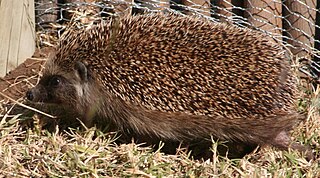 W
WThe Southern African hedgehog is a species of mammal in the family Erinaceidae. It is found in Angola, Botswana, Lesotho, Namibia, South Africa, Tanzania and Zimbabwe.
 W
WThe brown hyena, also called strandwolf, is a species of hyena found in Namibia, Botswana, western and southern Zimbabwe, southern Mozambique and South Africa. It is currently the rarest species of hyena. The largest remaining brown hyena population is located in the southern Kalahari Desert and coastal areas in Southwest Africa. The global population of brown hyena is estimated by IUCN at a number between 4,000 and 10,000 and its conservation status is marked as near threatened in the IUCN Red List.
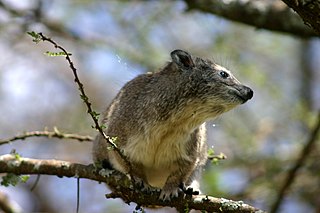 W
WThe southern tree hyrax or also known as the southern tree dassie is a species of mammal in the family Procaviidae. The southern tree hyrax is mainly found in the south central eastern side of Africa.
 W
WThe impala is a medium-sized antelope found in eastern and southern Africa. The sole member of the genus Aepyceros, it was first described to European audiences by German zoologist Hinrich Lichtenstein in 1812. Two subspecies are recognised—the common impala, and the larger and darker black-faced impala. The impala reaches 70–92 centimetres at the shoulder and weighs 40–76 kg (88–168 lb). It features a glossy, reddish brown coat. The male's slender, lyre-shaped horns are 45–92 centimetres long.
 W
WThe black-backed jackal is a canine native to eastern and southern Africa. These regions are separated by roughly 900 kilometers.
 W
WThe side-striped jackal is a canine native to central and southern Africa. Unlike the smaller black-backed jackal which dwells in open plains, the side-striped jackal primarily dwells in woodland and scrub areas.
 W
WThe greater kudu is a woodland antelope found throughout eastern and southern Africa. Despite occupying such widespread territory, they are sparsely populated in most areas due to declining habitat, deforestation, and poaching. The greater kudu is one of two species commonly known as kudu, the other being the lesser kudu, T. imberbis.
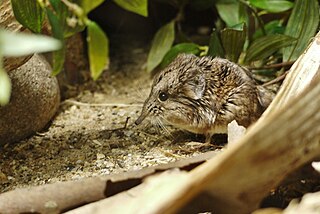 W
WThe round-eared elephant shrew or round-eared sengi, is a species of elephant shrew (sengi) in the family Macroscelididae. It is found in Botswana, Namibia, and South Africa. Its natural habitats are subtropical or tropical dry shrubland, subtropical or tropical dry lowland grassland, and hot deserts. They eat insects, shoots, and roots. Their gestation period is 56 days.
 W
WThe meerkat or suricate is a small mongoose found in southern Africa. It is characterised by a broad head, large eyes, a pointed snout, long legs, a thin tapering tail, and a brindled coat pattern. The head-and-body length is around 24–35 cm (9.4–13.8 in), and the weight is typically between 0.62 and 0.97 kg. The coat is light grey to yellowish brown with alternate, poorly defined light and dark bands on the back. Meerkats have foreclaws adapted for digging and have the ability to thermoregulate to survive in their harsh, dry habitat. Three subspecies are recognised.
 W
WThe Damaraland mole-rat, Damara mole rat or Damaraland blesmol, is a burrowing rodent found in southern Africa. Along with the smaller, less hairy, naked mole rat, it is one of only two known eusocial mammals.
 W
WThe Hottentot golden mole is a species of mammal in the golden mole family, Chrysochloridae. It is found in South Africa, Eswatini, and possibly Lesotho. Its natural habitats are temperate forests, subtropical or tropical dry forest, subtropical or tropical moist lowland forest, dry savanna, moist savanna, subtropical or tropical dry shrubland, Mediterranean-type shrubby vegetation, temperate grassland, subtropical or tropical dry lowland grassland, subtropical or tropical high-altitude grassland, sandy shores, arable land, pastureland, plantations, rural gardens, urban areas, and introduced vegetation.
 W
WThe Cape grey mongoose, also called the small grey mongoose, is a small mammal native to South Africa, Lesotho and southern Namibia.
 W
WThe yellow mongoose, sometimes referred to as the red meerkat, is a member of the mongoose family. It averages about 1 lb (1/2 kg) in weight and about 20 in (500 mm) in length. It lives in open country, from semi-desert scrubland to grasslands in Angola, Botswana, South Africa, Namibia, and Zimbabwe.
 W
WThe four-striped grass mouse or four-striped grass rat, is a species of rodent in the family Muridae.
 W
WThe Cape porcupine or South African porcupine, is a species of Old World porcupine native to central and southern Africa.
 W
WThe mountain reedbuck is an antelope found in mountainous areas of much of sub-Saharan Africa.
 W
WThe southern reedbuck, rietbok or common reedbuck is a diurnal antelope typically found in southern Africa. It was first described by Pieter Boddaert, a Dutch physician and naturalist, in 1785. It is placed in the genus Redunca and family Bovidae. This antelope has an average mass of 58 kg (128 lb) and a body length of about 134–167 cm (53–66 in).
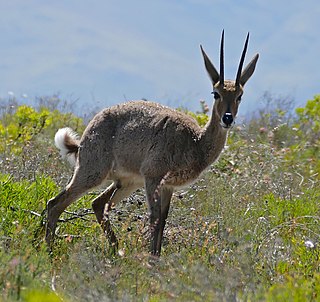 W
WThe grey rhebok or grey rhebuck, locally known as the reebok in Afrikaans, is a species of antelope native to South Africa, Zimbabwe, Lesotho, and Eswatini (Swaziland). The specific name capreolus is Latin for 'little goat'.
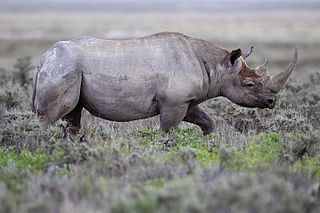 W
WThe black rhinoceros or hook-lipped rhinoceros is a species of rhinoceros, native to eastern and southern Africa including Angola, Botswana, Kenya, Malawi, Mozambique, Namibia, South Africa, Eswatini, Tanzania, Zambia, and Zimbabwe. Although the rhinoceros is referred to as black, its colours vary from brown to grey.
 W
WThe white rhinoceros or square-lipped rhinoceros is the largest extant species of rhinoceros. It has a wide mouth used for grazing and is the most social of all rhino species. The white rhinoceros consists of two subspecies: the southern white rhinoceros, with an estimated 19,682–21,077 wild-living animals in the year 2015, and the much rarer northern white rhinoceros. The northern subspecies has very few remaining individuals, with only two confirmed left in 2018, both in captivity. Sudan, the world's last known male northern white rhinoceros, died in Kenya on 19 March 2018.
 W
WThe brown fur seal, also known as the Cape fur seal, South African fur seal and Australian fur seal, is a species of fur seal.
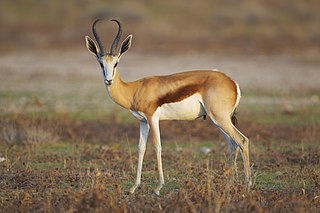 W
WThe springbok is a medium-sized antelope found mainly in southern and southwestern Africa. The sole member of the genus Antidorcas, this bovid was first described by the German zoologist Eberhard August Wilhelm von Zimmermann in 1780. Three subspecies are identified. A slender, long-legged antelope, the springbok reaches 71 to 86 cm at the shoulder and weighs between 27 and 42 kg. Both sexes have a pair of black, 35-to-50 cm (14-to-20 in) long horns that curve backwards. The springbok is characterised by a white face, a dark stripe running from the eyes to the mouth, a light-brown coat marked by a reddish-brown stripe that runs from the upper fore leg to the buttocks across the flanks like the Thomson's gazelle, and a white rump flap.
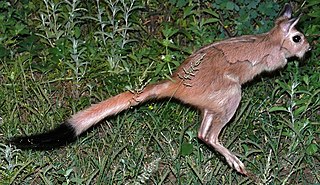 W
WThe South African springhare, or springhaas in Afrikaans, is not actually a hare, but a large and unusual rodent. It is one of two extant species in the genus Pedetes, and is native to southern Africa. Formerly, the genus was considered monotypic and the East African springhare was included in P. capensis. Though the species look alike at a casual glance, scientific study can easily determine which is which.
 W
WThe black wildebeest or white-tailed gnu is one of the two closely related wildebeest species. It is a member of the genus Connochaetes and family Bovidae. It was first described in 1780 by Eberhard August Wilhelm von Zimmermann. The black wildebeest is typically 170–220 cm (67–87 in) in head-and-body length, and the typical weight is 110–180 kg (240–400 lb). Males stand about 111–121 cm (44–48 in) at the shoulder, while the height of the females is 106–116 cm (42–46 in). The black wildebeest is characterised by its white, long, horse-like tail. It also has a dark brown to black coat and long, dark-coloured hair between its forelegs and under its belly.
 W
WThe blue wildebeest, also called the common wildebeest, white-bearded wildebeest, or brindled gnu, is a large antelope and one of the two species of wildebeest. It is placed in the genus Connochaetes and family Bovidae, and has a close taxonomic relationship with the black wildebeest. The blue wildebeest is known to have five subspecies. This broad-shouldered antelope has a muscular, front-heavy appearance, with a distinctive, robust muzzle. Young blue wildebeest are born tawny brown, and begin to take on their adult coloration at the age of 2 months. The adults' hues range from a deep slate or bluish-gray to light gray or even grayish-brown. Both sexes possess a pair of large curved horns.
 W
WThe mountain zebra is a zebra species in the family Equidae.
 W
WThe plains zebra, also known as the common zebra, is the most common and geographically widespread species of zebra. Its range is fragmented, but spans much of southern and eastern Africa south of the Sahara. Six subspecies have been recognised including the extinct quagga which was thought to be a separate species. However, more recent research supports variations in zebra populations being clines rather than subspecies.